Puppetry and Texture Part 1
This essay was originally commissioned for a book. Alas it was not accepted. Please accept it here in three parts. You’ll notice that the style is slightly more formal than usual. That shouldn’t be a problem should it?
…..
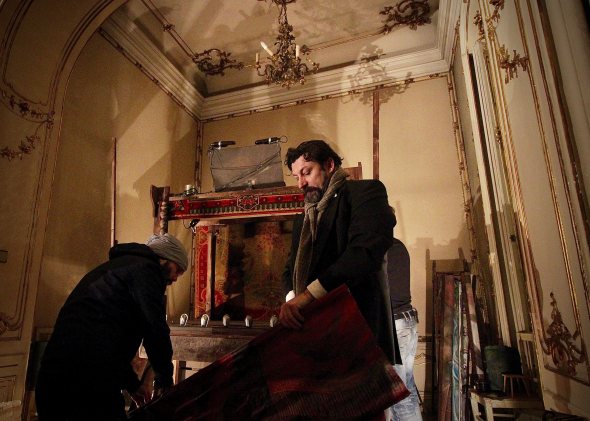
Handa Gote’s Tomáš Procházka striking a very textured set for extremely textural antique style puppets in a retro version of the Czech puppetry classic Faust.
I think puppetry is magic. Because you animate matter, make it alive. It’s the process of animation. You take a piece of wood, or whatever you’ve found, you are able to do some theatre with it. Or any kind of art. The process for me is the most interesting and important thing. I still feel like it’s magic. It’s like the photograph. You have traditional photography and it’s still connected to alchemy, because you literally capture the light by means of a chemical process. It’s all very tactile and physical. And digital photography, it’s all about watching these small screens. And it’s just about information. It’s completely virtual. And puppet theatre for me is about the physical experience, about the tactility, about how you change things by touching them. So for me it’s very physical.
Tomáš Procházka, Puppeteer with Buchty a Loutky, Prague 2012* (Later with Handa Gote)
…..
Puppets have texture.
It doesn’t sound like a radical notion. Not too long ago such a statement could easily have been put into the category of obvious, so obvious as to be unremarkable. Today it stands out as almost something of a miracle. In a world of dead surfaces: the flatness of glass on the sides of buildings, stainless steel walls, enamel refrigerators, plastic tables, white painted walls, faux materials and, most of all, the unbroken smoothness of the screens engulfing our imaginations, to say that puppets have texture suddenly seems like a mighty contradiction of the realities that have been created for us to inhabit. And yet we can now say it with courage: Puppets have texture.
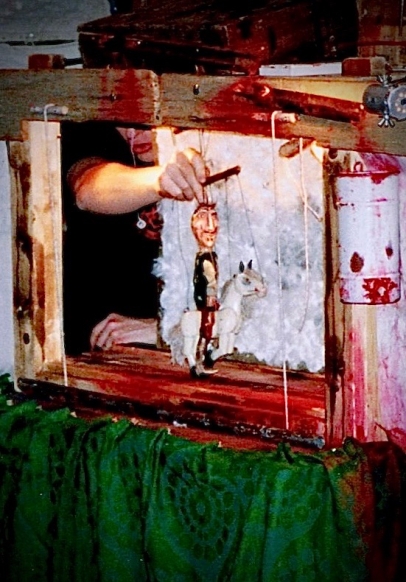
Buchty a loutky’s strange patchwork puppetry in Prague; including funky homemade stages, battered puppets, even blood runnels.
We often ask questions of ecology. What is the proper environmental habitat for creatures to live in? Humanity is something that we often assume should fit into this imagined ecosphere the way a frog does. And yet this only demonstrates a paucity of imagination. We rarely ask this question: What is the proper environment for a human being to live in? Yet without asking this question we often end up in such contradictions as the creation utopian communities which lack much of what makes the human experience worth living. Or we find people who lament the loss of natural habitat for snails and swans while simultaneously living themselves in cramped apartments, in crowded cities, in suburbs designed for automobiles, in universities of sterile modern architecture, eating processed instant food, injecting coffee into our veins to stay alive, turning music into the interpretive background score of our personal film through headphones, selfies taken to validate our passing through an unmemorable landscape, cruise ships that seem to keep us in one place as we move through space, endlessly addictive flickering images on our screens, which now are held in our hands. We don’t ask how much of this new environment is the place where a human can flourish. (And it really has appeared like lightning out of non-existence less than a hundred years ago.)

Like an Escher with advertisements. The sickly sweet rosy world of a mall in Warsaw, Poland.
The world we now live in is a rapidly changing unknown moving towards a total encirclement. It is a product of the more reductive experiments of Modernism (Bauhaus, Pop Art, Minimalism, etc) in an unholy commingling with the commercial forces of this world. While those art movements meant to focus us upon uncluttered form, the market realized very quickly that to eliminate the last vestiges of bourgeois ornamentation would be a boon to economical production. Thus by the 1960s most industries that crafted home merchandise had begun the shift from the solidly manufactured products of the 1950s to the more cheaply made and far more disposable world we now inhabit. Skyscrapers were made to look eternally new. Kitchens were made to be the most sanitary and empty rooms on the house. Art galleries objectify their wares by hanging them in utter isolation on blank walls. Shopping mutated into a journey into the deadest of spaces devoid of humanity, all utility, all prosaic shapes and angles in ‘big box stores’. Plastic was molded to look like any number of materials. ‘Contact paper’ with photos of wood grain was glued to the pressed debris of the lumber industry to imitate planks of oak or pine. The car became another dead zone waiting to be filled with the waste products of the fast-food industry. And into this toxic antiseptic landscape the screen increasingly was placed to mediate our nullity. Think of the last airport you spent much time in. Think of the GPS navigators in your vehicles. Think of your white living room wall punctuated by a flatscreen television. Look to your palms. A device so insidious that it keeps you from noticing the world, the trashy, dead, horrifically colored, brutally designed, world around you.
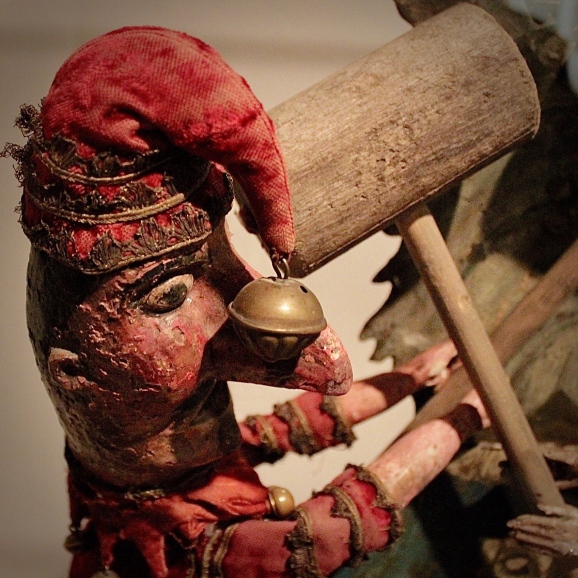
Jan Švankmajer’s purposely corroded looking Kašpárek (the Czech Punch figure) from his miniature masterpiece Rakvičkárna, mistakenly entitled Punch and Judy in English.
Oliver Grau and Thomas Vogel in the Introduction to their book, Imagery in the 21st Century†, have written: “Never before has the world of images around us changed so fast, never before have we been exposed to so many different image worlds, and never before has the way in which images are produced changed so fundamentally.”
And again: “The historical development of images, between innovation, reflection, and iconoclasm, is reaching a new level of global complexity in the twenty-first century. These transformations have hit a society that is to a large extent unprepared.”
And then there is the puppet. Not the puppet as toy, another cute entity for distraction, but the puppet, handmade, conceived as performer, as solitary three dimensional presence, made of wood, papier-mâché, bone, fabric, metal, etc. This figure does not fit into the flat landscape. It sits in the corner cautiously. There is a mystery to it. (Which is why some people fear the puppet.) Questions emanate from it. Questions about why we make our mirrors of such rough textures.
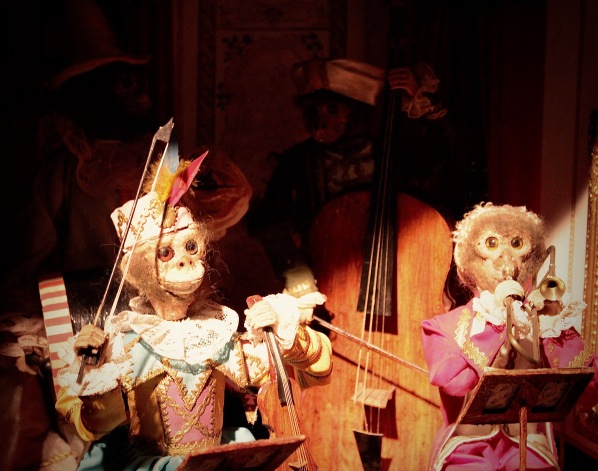
The kind of musical automata that inspired the introduction to Jan Švankmajer’s Rakvičkárna.
The texture of the puppet. That is what in inspired me to begin to investigate puppetry back in the late 90’s. I had seen the odd puppet films Jan Švankmajer and the Brothers Quay. And while I was impressed by their techniques, something else was speaking to me. The puppets themselves. Švankmajer seemed to go out of his way to add texture upon texture in films like Rakvičkárna (The Coffin Factory or Punch and Judy) where his two malevolent hand puppets smack each other silly in an environment of burlap, pages from old books and newspapers, badly painted automaton monkeys and a live guinea pig. Even the two puppets, not Punch and Judy but rather a Kašpárek and Harlequin, are purposely stressed and corroded in their appearance. And their puppet smocks likewise are texturally alive. The Quays likewise would use textures like a musical score: iron shavings, meat, dust, rubber bands, scissors, light bulbs, dirty glass, and old doll parts. And while their work hearkened to a gray (now mythic) Communist age, nevertheless in these evocations one could see the value of that grayness in contrast to slick illusions of high tech hypermodernity. (More than one puppeteer who had operated behind the old Iron Curtain has expressed a strange nostalgia for the gray, in contrast the ‘bright’ shiny present.)
This set a beacon for me to follow.

Shadowy figures in the Quays’ London Atelier Koninck QbfZ. (Now sadly passing into history.)
To be continued…
Byrne Power
Tbilisi, Georgia
November 3rd 2019
…..
Puppetry and Texture Part 2 coming within the week.
…..
And hey we could really use your support in our continuing effort to try to get this documentary finished. Use PayPal from anywhere you are and contribute to Gravity From Above: A Journey Into European Puppetry

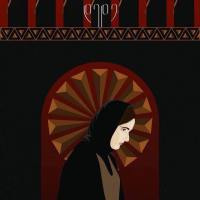

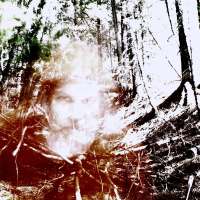



Pingback: Puppetry and Texture Part 3 | GRAVITY FROM ABOVE